First light
Joining on to build the next biggest and best telescope, Chicago secures its astrophysics footing.
By Benjamin Recchie, AB’03
Photos by Mike Gladders and Hsiao-Wen Chen
Rendering courtesy the Giant Magellan Telescope Project
Over the next decade, an international team of scientists and engineers will construct a scientific behemoth high in the Andes Mountains. The Giant Magellan Telescope will be more than 200 feet high and weigh hundreds of tons. It will see the first stars that ever shone and Earth-like planets around distant suns. It will be more than four times larger than any optical telescope in existence today, and the University of Chicago will help to build it.
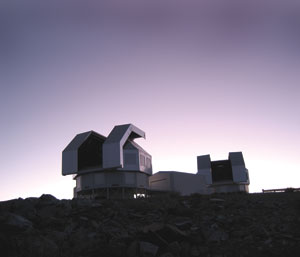
The twin Magellan telescopes at Chile’s Las Campanas Observatory.
Although Chicago’s Department of Astronomy and Astrophysics consistently ranks as one of the finest, it lags its peers in one important regard: dedicated time on a top-tier telescope. It wasn’t always so, as department chair Rocky Kolb notes: “When George Ellery Hale founded Yerkes Observatory [in 1897], it had the world’s largest telescope.” As telescopes grew, the University continued to invest in newer instruments (see “A Little History of Big Glass”). But in the past two decades, while Chicago’s peers moved on to the latest generation of large optical telescopes (known as the “eight-meter class,” referring to the diameter of their primary mirror), the University was left behind. Without the financial resources to buy dedicated time on an eight-meter-class instrument, Chicago astronomers either had to partner with a collaborator at an institution that had purchased observatory time, Kolb says, or compete for scarce hours at a publicly owned telescope. The lack of a dedicated telescope has impeded the department when competing for faculty and students.
In 2010 the University inked a deal to remedy this problem in the short term, paying $12 million to buy time on the Magellan telescopes, a pair of 6.5-meter instruments at Las Campanas Observatory in Chile. Carnegie Observatories manages the telescopes for its partners, which include the Carnegie Institution of Washington, Smithsonian Astrophysical Observatory, the University of Arizona, Harvard University, the University of Michigan, and MIT. Chicago’s investment reserves about 10 percent of observation nights for University teams.
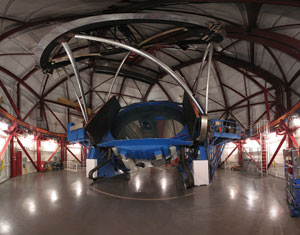
A telescope’s guts: Inside one of the twin Magellans, the Walter Baade Telescope, where Chicago teams now have dedicated observation time.
The agreement with the Magellan consortium finally puts Chicago on an equal footing with its peers. But the University won’t stop there. “Every 20 years or so, the size of telescopes doubles,” says Kolb. “The current Magellan telescopes will give us access to the top instruments in astronomy for the next ten to 15 years. After that, it will be a new generation, and we want to be in on the ground floor.” So Chicago is planning for its next telescope: Magellan’s big brother.
When searching for a suitable site for an observatory, astronomers have a simple mantra: “high and dry.” High as in altitude, so that most winds and currents of Earth’s image-distorting atmosphere remain below the telescopes. Dry as in low humidity and precipitation: water vapor blurs starlight and blocks out certain wavelengths of light altogether.
There are few higher and drier places on Earth than the Chilean Andes, and even fewer than the Las Campanas Observatory. Built on a sere mountaintop, Las Campanas is a “quite extraordinary place,” says Mike Gladders, assistant professor of astronomy and astrophysics. (He should know: he’s visited there 36 times.) Because of its ideal climate, several major telescopes—including the twin Magellans—have been built in Chile since 1976.
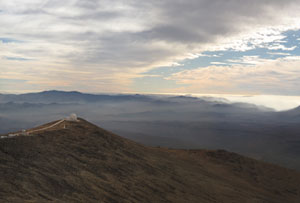
The Chilean Andes are high and dry, perfect for an optical telescope.
The University had additional reasons for joining a telescope project in Chile over Hawaii or the Canary Islands, popular sites for other large telescopes. For one, Chicago scientists help to operate the South Pole Telescope (which detects microwave radiation) in Antarctica and the Pierre Auger Observatory (which detects cosmic rays) in Argentina; having a large optical observatory to correlate microwave observations from the South Pole and cosmic rays from South America gives astronomers multiple views of the same objects in the southern sky. Meanwhile Chicago already has ties with Chile: University economists have a well-known, if controversial, history with the government. About five years ago the Harris School of Public Policy developed a cooperative master’s-degree program with the University of Chile, and this past November the school cohosted an education summit in Santiago with a local organization. Four Chicago alumni serve in the current Chilean cabinet, and in December University President Robert J. Zimmer attended a reception to present one of them, Minister Secretary of the Presidency Cristián Larroulet, AM’80, with a 2010 Alumni Association Professional Achievement Award. Says Kolb, “It’s not just astronomy in Chile—it’s part of a broad University engagement” in the country.
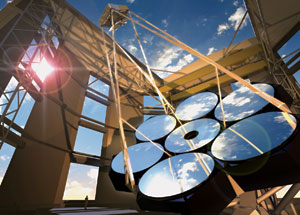
This rendering shows how the Giant Magellan Telescope’s six large mirrors will encircle a seventh.
That engagement will continue with the next generation of instruments. As useful as the current Magellan telescopes are, they’ll soon be outclassed by near-30-meter mirrors. So the Giant Magellan Telescope Organization, a partnership between ten institutions including Chicago, hopes to construct a new telescope, near the existing Magellan instruments, with seven mirrors working in concert, equivalent to one 24.5-meter mirror. Four times the size of any other optical telescope to date, it will cost $700 million to build, and Chicago will own five percent of it.
The greater the diameter of a telescope’s mirror, the more light it can collect, and the fainter the objects it can detect. But building a telescope with a single mirror 24 meters across, to say nothing of transporting it for any distance, would be extraordinarily difficult. A piece of glass that size would collapse under its own weight.
Instead, the 30-meter-class telescopes—two others are planned, one in Hawaii and one also in Chile—are designed with multiple mirrors. The Giant Magellan Telescope, for example, has seven mirrors, each one 8.4 meters in diameter—a measure dictated not by technical considerations but by logistical ones. The mirrors are cast and ground in a lab under the University of Arizona football stadium, limited by the spacing of the stadium’s support beams.
In this basement lab, engineers “spin cast” the mirrors. Over the course of a week, they melt borosilicate glass and fuse it together in a mold to form a massive disk with a relatively lightweight, honeycomb structure. After the mirrors have solidified, engineers will spend almost a year polishing each one to within 20 nanometers—less than one-thousandth the width of a human hair—of a perfect paraboloid. Any larger variance throws the instrument out of focus.
Each 20-ton mirror will be trucked from Tucson to Long Beach, California; packed onto a ship; transported to Coquimbo, Chile; and then carefully trucked up the mountains to Las Campanas for assembly. Six mirrors will surround a seventh in the center, aligned in yet another paraboloid, to focus light into much smaller secondary mirrors, which in turn reflect light through a hole in the central primary mirror that leads to the telescope’s cameras and other instruments. Despite the mirrors’ immense weight, the steel frame holding them together will keep them steady even through 35-mile-per-hour crosswinds.
While the mirrors’ size and precision should provide for excellent imaging ability, designers have planned a further refinement: adaptive optics. In the system envisioned for the Giant Magellan Telescope, a laser will map the turbulence of the column of air between the observatory and the near vacuum of space in real time. Operators will use that measurement to adjust the telescope’s secondary mirrors at a rate of 500 to 1,000 times per second, improving the telescope’s ability to discern fine detail, a measure called angular resolution. The designers expect that the instrument’s image quality will be better than that of the space-based Hubble Space Telescope. In other words, says Gladders, “the image will be almost as good as if the atmosphere wasn’t there.”
As much as the Giant Magellan Telescope may change contemporary astronomy, it may also change Chicago’s astronomy department. Chicago’s five-percent share means five percent of all observing nights will be reserved for Chicago scientists. That access will help to recruit faculty and graduate students and will help to diversify the department’s currently theory-heavy research program. “The GMT’s capabilities are sufficiently diverse that access to the telescope will definitely attract scholars with a broad range of interests to come to Chicago,” says Richard Kron, professor of astronomy and astrophysics, who chairs a study group examining how the department can contribute to the telescope and vice versa.
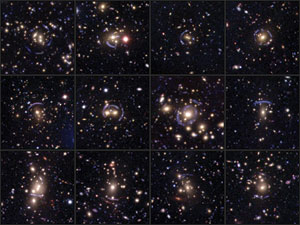
The new telescope will provide astrophysicists such as Mike Gladders with top-notch instruments to study how galaxy clusters' gravity bends light paths.
Using the Giant Magellan Telescope, Chicago researchers for the first time will be able to study exoplanets, planets that orbit stars other than our sun. Astronomers have discovered roughly 500 such planets since the first confirmed discovery in 1995. Most exoplanets are miniscule with respect to their parent star, and all are much fainter than their sun, so observers must use subtle methods (gravitational microlensing, radial velocity, planetary transits, pulsar timing) to detect them. Still, nearly every exoplanet discovered so far has been much larger than Earth; astronomers theorize that this is not because Earth-sized planets are rare but rather because larger planets are easier to detect. With its high angular resolution, the new telescope could directly observe smaller, Earth-like planets around other stars—assuming the theorists are right.
Trying to observe exoplanets requires more than just power—it also requires patience. Not having dedicated access to a large telescope prevented Chicago from building a research group in exoplanetary studies, explains Kolb. “This is an exciting field that’s only been around for ten years or so.” With the existing Magellan telescopes, he says, “we’ll start up, and with the GMT we’ll be among the leaders” in the field.
Astronomers also hope that the telescope’s size and light-collecting ability will make it function as a “time machine,” as Kron puts it. Astronomers see distant objects not as they are today, but as they were when their light left them. For an object a billion light-years away, we see it as it was a billion years ago. The more distant the object, the farther back in time we see it—and the more clues astrophysicists have to how the universe formed.
“One of the stated principal goals of the GMT,” Gladders says, “is to come to terms with ‘first light,’” the period in the early universe when the first stars started to shine. Over millions of years, those first stars coalesced into clumps that became the first large-scale structures—galaxies and quasars (distant galaxies that emit more electromagnetic energy than anything else in the universe).
The oldest quasar yet observed, explains Hsiao-Wen Chen, assistant professor of astronomy and astrophysics, dates from 500 million years after the big bang. (By comparison, the universe is thought to be roughly 13.5 billion years old.) But “where we see a quasar at 500 million years of age, there have to be other smaller, lower-mass galaxies floating around at an earlier time” preceding the quasar, she says. Astronomers hope the new telescope will give them sufficient power to observe objects from what they call the epoch of reionization—the time when the universe cooled enough to become transparent. Because the universe was previously opaque, these are by definition the earliest objects that could ever be seen.
Beyond exoplanets and early protogalaxies, the most exciting discoveries to come from the Giant Magellan Telescope may be in fields not yet developed. “It’s appreciated more by scientists than by other people,” admits Kolb, “to say, ‘We’re building this, but we don’t know what the greatest discovery is going to be.’”
Even after the instrument becomes operational in 2019, the University intends to maintain its investment in the older Magellan telescopes. Long after they’ve lost first-class status, telescopes are still useful, often repurposed as survey telescopes. Such is the fate of the twin Magellan telescopes; they will lay the groundwork for more detailed observations with the powerful new instrument.
The other 30-meter-class telescopes planned—the Thirty Meter Telescope, proposed for Hawaii, and the 42-meter European Extremely Large Telescope, also proposed for Chile, will be larger than the Giant Magellan Telescope. All three are scheduled to be operational by decade’s end, but only the GMT has begun construction. If the other projects fall behind, it’s possible that the Giant Magellan will temporarily hold the title of world’s largest optical telescope.
Record breaking or not, the Giant Magellan Telescope will be, Gladders says, an “engine for advancement” for astrophysics. “There’s a lot of work to do between now and 2019,” he adds. Then, after a long absence, Chicago will resume its place in the constellation of great observatories.
A little history of big glass
| Year: 1897 Diameter: 40 inches (1.0 meters) Location: Yerkes Observatory, Williams Bay, Wisconsin The largest refracting telescope (using lenses instead of mirrors) in the world, it’s still owned by the University at Yerkes Observatory. |
|||||
| Year: 1939 Diameter: 82 inches (2.1 meters) Location: McDonald Observatory, Jeff Davis County, Texas Chicago operated McDonald Observatory on behalf of the University of Texas from 1932 to 1962. Its 82-inch telescope, named for former Yerkes director Otto Struve, PhD’23, was the world’s second-largest at the time. |
|||||
| Year: 1994 Diameter: 3.5 meters Location: Apache Point Observatory, Sunspot, New Mexico Operated by an eight-member collaboration including Chicago, the 3.5-meter telescope has been the University’s largest instrument for the past 15 years. |
|||||
| Year: 2000/2002 Diameter: 6.5 meters each Location: Las Campanas Observatory, Chile Chicago has dedicated access to the twin Magellan telescopes starting this January. |
|||||
| Year: 2019 (projected) Diameter: 24.5 meters (equivalent) Location: Las Campanas Observatory, Chile Composed of seven mirrors acting as one, when completed the Giant Magellan Telescope will be one of the three largest telescopes.
|
|||||
WRITE THE EDITOR
DISCUSS THIS ARTICLE
E-MAIL THIS ARTICLE
SHARE THIS ARTICLE
MORE FROM THE MAGAZINE
RELATED LINKS
RELATED VIDEO
RELATED READING
- Richard Kron to Chair Science Advisory Committee of Giant Magellan Telescope (University of Chicago News Office, February 9, 2011)
- Pledge Drive: Students at Chicago raise funds for Chilean earthquake relief (University of Chicago Magazine, May–Jun/10)
